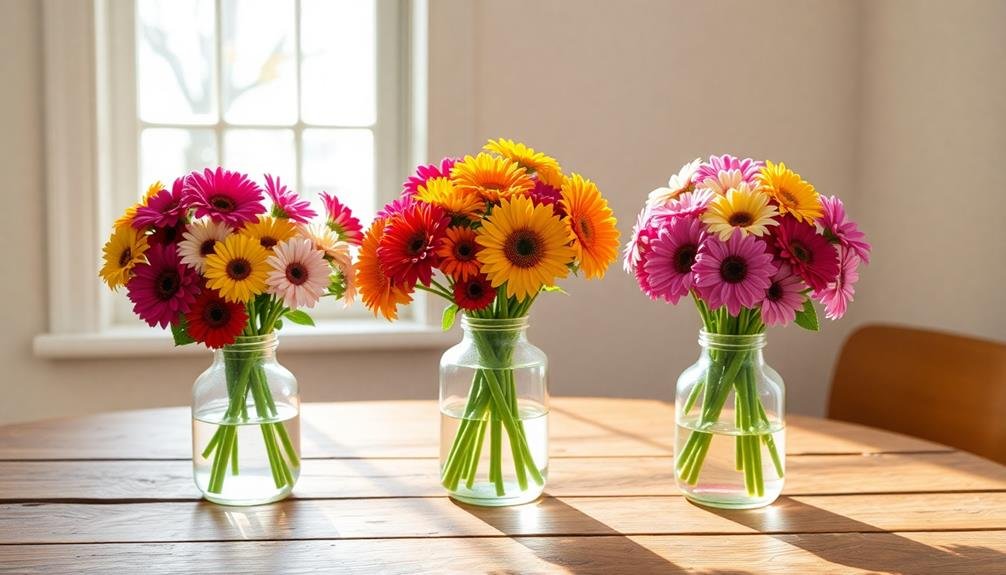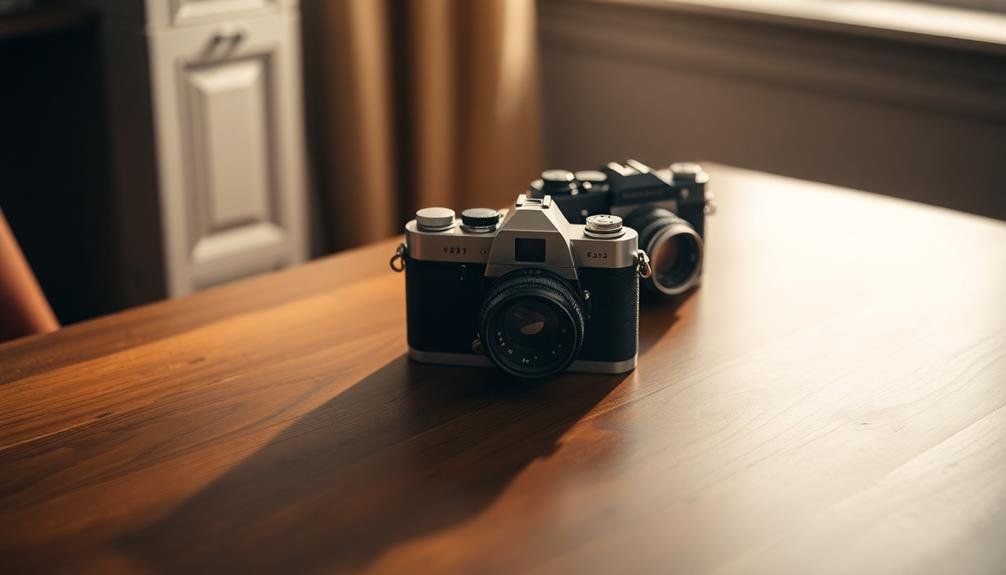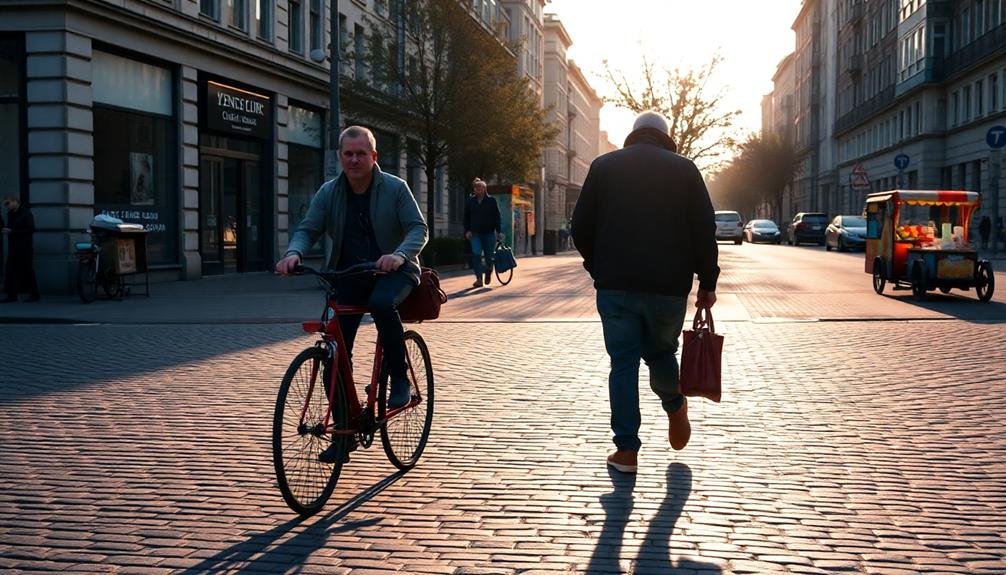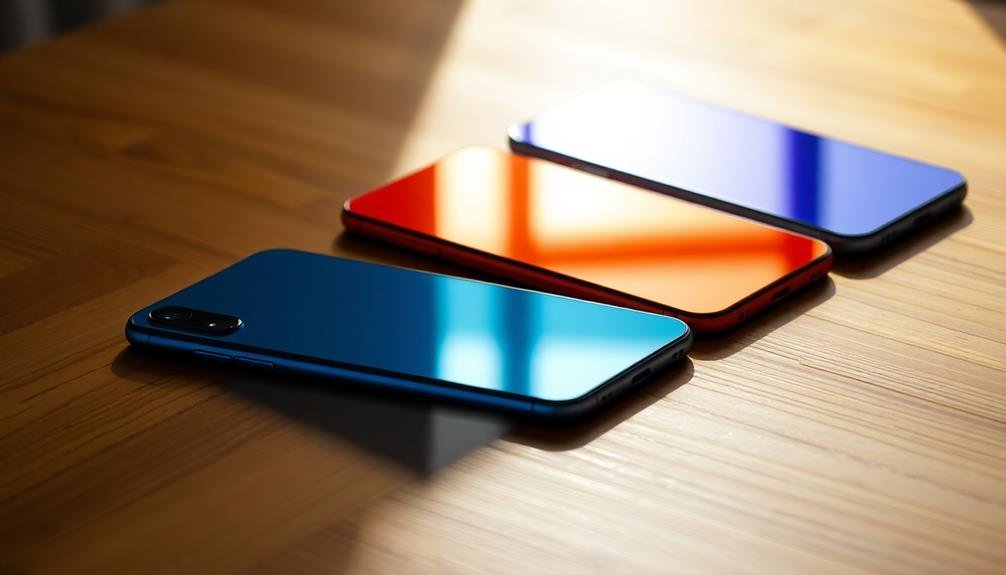The Rule of Odds is a powerful composition technique for mobile photography that suggests using odd numbers of subjects (3, 5, 7) to create visually appealing images. It's based on the psychology that odd-numbered groupings feel more dynamic and engaging to viewers. You can apply this rule in various scenarios, from landscapes and portraits to still life and street photography. By arranging subjects in odd numbers, you'll add balance and visual interest to your shots. Combine the Rule of Odds with other composition techniques like framing and leading lines for even more impact. With practice and the right editing apps, you'll reveal a secret to creating stunning smartphone photos that captivate your audience.
What Is the Rule of Odds?

The Rule of Odds is a composition principle in photography that suggests using an odd number of subjects in your frame. This guideline encourages you to include three, five, or seven elements in your mobile photos rather than even numbers.
The theory behind this rule is that odd numbers create a sense of balance and visual interest that's more appealing to the human eye.
When you're composing your shot, look for opportunities to group subjects in odd numbers. For example, if you're photographing flowers, try to capture three blooms instead of two or four. The same applies to people, objects, or any other elements in your scene.
Odd numbers create a central focal point with supporting elements on either side, which naturally guides the viewer's eye through the image.
You'll find that odd-numbered groupings often feel more dynamic and less rigid than even numbers. They create a subtle asymmetry that adds tension and energy to your photos.
While it's not a strict rule, understanding and applying the Rule of Odds can appreciably enhance your mobile photography composition skills and help you create more visually engaging images.
Psychology Behind Odd Numbers

Many psychological studies have explored why odd numbers are more visually appealing to humans. The human brain naturally seeks patterns and symmetry, but it also craves a bit of intrigue. Odd numbers provide this balance, offering just enough asymmetry to keep things interesting without becoming chaotic.
When you're composing your mobile photos, using odd-numbered groupings can create a sense of dynamic tension. This subtle imbalance forces the viewer's eye to move around the image, engaging them more deeply with your composition.
Odd numbers also tend to feel more natural and organic, mirroring patterns found in nature.
You'll find that groupings of three, five, or seven elements are particularly effective in photography. These numbers create a central focal point with supporting elements on either side, guiding the viewer's gaze. They also provide a sense of completeness that even numbers lack.
Applying Rule of Odds

Applying the Rule of Odds in mobile photography is simpler than you might think. Start by looking for scenes with odd-numbered elements, as they're naturally more pleasing to the eye. When framing your shot, aim to include 3, 5, or 7 main subjects rather than even numbers.
For landscapes, you might capture three trees on a horizon or five boats in a harbor. In street photography, focus on three people walking together or five pigeons on a sidewalk. When shooting still life, arrange objects in odd-numbered groups, like three coffee cups or five pieces of fruit.
Don't forget that the Rule of Odds can also apply to lines and shapes. You can incorporate three parallel lines in architecture or five geometric shapes in urban environments.
Remember, you don't always need to fill the frame with odd-numbered subjects. Sometimes, leaving negative space around three main elements can create a powerful composition.
Experiment with different odd numbers and subject arrangements. As you practice, you'll develop an intuitive sense for when and how to apply this rule effectively in your mobile photography.
Odd-Numbered Subjects in Landscapes

Landscapes offer abundant opportunities to incorporate the Rule of Odds in your mobile photography. When capturing natural scenes, look for groupings of three, five, or seven elements to create visually appealing compositions.
You'll find these odd-numbered arrangements in various forms, such as trees, rocks, mountains, or even clouds. For example, when photographing a coastline, focus on three distinct rock formations jutting out of the water.
In a forest setting, frame your shot to include five trees in the foreground. When capturing rolling hills, compose your image to showcase three prominent peaks.
Don't limit yourself to just natural elements. Man-made structures in landscapes can also follow the Rule of Odds. Capture three windmills on a rural horizon or five boats moored in a lake.
Even wildlife can be incorporated – try to photograph three birds perched on a branch or five deer grazing in a field.
Portrait Photography With Rule of Odds

Faces tell stories, and the Rule of Odds can help you capture them more effectively in portrait photography. When shooting portraits with your mobile device, consider framing your subject with an odd number of elements. This creates a more visually appealing and balanced composition that draws the viewer's eye to the main subject.
Try positioning your subject between two objects, like trees or columns, to create a trio. Or, capture a group of three people, with the main subject in the center. You'll find that these odd-numbered arrangements feel more natural and dynamic than even-numbered ones.
Here are some ways to incorporate the Rule of Odds in portrait photography:
- Use background elements to frame your subject in groups of three
- Capture families or friend groups in odd numbers
- Incorporate odd-numbered props or accessories
- Experiment with triple exposures or triptychs
Still Life Compositions

While portraits focus on human subjects, still life compositions offer a unique opportunity to apply the Rule of Odds in mobile photography. You'll find that arranging objects in odd numbers creates a more visually appealing and balanced image. Start by selecting three, five, or seven items for your composition. This odd grouping naturally draws the viewer's eye and creates a sense of harmony.
When setting up your still life, consider varying the heights, shapes, and textures of your objects. Place the tallest or most prominent item in the center, flanked by smaller elements. This arrangement creates a focal point and adds depth to your image.
Don't be afraid to experiment with asymmetry; it can add interest and dynamism to your composition. Pay attention to negative space, using it to frame your objects and create breathing room in the image.
Adjust your mobile camera's focus to highlight specific elements, and use natural light to enhance textures and shadows. Remember, the Rule of Odds isn't a strict law but a guideline. Trust your artistic instincts and break the rule when it serves your creative vision.
Street Photography Techniques

Street photography presents a dynamic canvas for applying the Rule of Odds. As you navigate bustling city streets, you'll encounter numerous opportunities to capture compelling compositions. Look for groups of three or five subjects to create visually appealing images that draw the viewer's eye. Whether it's people waiting at a bus stop, street vendors, or architectural elements, odd-numbered groupings add interest and balance to your shots.
When composing your street photographs, consider these techniques:
- Use leading lines to guide the viewer's attention to your odd-numbered subjects
- Incorporate reflections in windows or puddles to create intriguing compositions
- Capture candid moments of interaction between people in groups of three or five
- Frame your subjects using architectural elements like doorways or arches
Remember to be discreet and respectful when photographing strangers. Quick reflexes are essential in street photography, so keep your mobile device ready at all times.
Experiment with different angles and perspectives to add depth to your images. Don't be afraid to crop your photos later to emphasize the Rule of Odds in post-processing. With practice, you'll develop an eye for spotting and capturing odd-numbered groupings in the urban landscape.
Framing With Odd-Numbered Elements

Framing your mobile photography subjects with odd-numbered elements can elevate your compositions to new heights. This technique creates a sense of balance and visual interest that's more appealing to the human eye. When you're out shooting with your smartphone, look for opportunities to incorporate groups of three, five, or seven objects into your frame.
Start by identifying your main subject, then search for odd-numbered elements to surround it. These could be anything from trees and lampposts to people or architectural features. Position your subject off-center using the rule of thirds, and arrange the odd-numbered elements around it. This creates a dynamic composition that guides the viewer's eye through the image.
Don't force the technique if it doesn't naturally fit the scene. Instead, train your eye to spot odd-numbered groupings in your environment. You might find three birds on a wire, five flowers in a garden, or seven windows on a building facade.
Balancing Asymmetry in Photos

Asymmetry-balance mastery can take your mobile photos to the next level. When incorporating the Rule of Odds, you'll often create asymmetrical compositions. The key is to balance these uneven elements effectively.
Start by identifying your main subject and placing it off-center. Then, use secondary elements to counterbalance the visual weight.
Consider the following techniques to achieve balance in asymmetrical compositions:
- Use negative space to offset a strong visual element
- Incorporate leading lines to guide the viewer's eye
- Play with color contrast to create visual interest
- Leverage the rule of thirds grid on your phone's camera app
Remember, balance doesn't always mean equal distribution. It's about creating a harmonious overall feel.
Experiment with different arrangements of odd-numbered elements until you find a pleasing composition. Pay attention to how your eye moves through the frame. If it feels natural and engaging, you've likely achieved a good balance.
Don't be afraid to break the rules occasionally. Sometimes, intentional imbalance can create dynamic, eye-catching images.
The more you practice balancing asymmetry, the more intuitive it will become, allowing you to capture stunning mobile photos with ease.
Odd Numbers in Minimalist Compositions

When it comes to minimalist compositions, the Rule of Odds can be particularly powerful. In mobile photography, you'll often find that using an odd number of subjects creates a more visually appealing and balanced image.
This technique works especially well in minimalist shots, where every element carries significant weight. Try incorporating three, five, or seven subjects in your frame. Odd numbers create a sense of harmony and prevent the eye from splitting the image into equal halves.
For example, when photographing a still life, arrange three objects instead of two or four. This arrangement feels more natural and dynamic.
In landscape shots, you might include three trees or five rocks in the foreground. For street photography, capture three people walking or five birds perched on a wire.
The key is to keep the composition simple while leveraging the power of odd numbers.
Breaking the Rule Effectively

While the Rule of Odds can enhance your mobile photography, don't be afraid to break it for creative effect.
You can create striking images by using intentional symmetry, which can convey balance and harmony in your compositions.
Additionally, experiment with combining odd and even numbers of elements to add visual interest and challenge viewer expectations.
Intentional Symmetry for Impact
Despite the Rule of Odds' effectiveness, intentionally breaking it with symmetry can create powerful visual impact in mobile photography. When you choose symmetry over odd numbers, you're making a bold statement that demands attention.
Symmetrical compositions can evoke feelings of balance, harmony, and order, which can be particularly striking in certain scenes.
To effectively use symmetry in your mobile photos:
- Find a strong central focal point
- Align your shot precisely using your phone's grid feature
- Look for naturally occurring symmetry in architecture or landscapes
- Create artificial symmetry by carefully arranging subjects
When you're composing a symmetrical shot, pay close attention to the details. Even slight misalignments can disrupt the overall effect.
Use leading lines to draw the viewer's eye to the center of your image, enhancing the symmetrical impact. Remember, symmetry doesn't always mean perfect mirror images; you can also explore near-symmetry or partial symmetry for a subtler effect.
Odd-Even Number Combinations
Many skilled mobile photographers understand that breaking the Rule of Odds can lead to compelling compositions. While odd numbers often create visual interest, combining odd and even numbers can produce striking results.
You'll find that this approach adds a layer of complexity to your mobile photography, challenging viewers' expectations.
To effectively blend odd and even elements, start by identifying your main subject. Then, strategically place an even number of supporting elements around it. For example, frame a single tree with two buildings on either side. This creates a balanced yet intriguing composition that draws the eye.
Another technique is to use an even number of primary subjects with an odd number of secondary elements. Try capturing two people surrounded by three distinct background features. This combination maintains visual harmony while adding depth to your image.
Don't be afraid to experiment with larger numbers. A group of four friends posing in front of five colorful doors can create a visually appealing contrast.
Combining With Other Composition Techniques

To elevate your mobile photography, combine the Rule of Odds with other composition techniques. This powerful approach enhances your images' visual impact and creates more dynamic compositions. By incorporating the Rule of Odds with techniques like leading lines, symmetry, or the golden ratio, you'll create visually striking photos that captivate viewers.
When combining composition techniques, remember to prioritize the Rule of Odds as your primary focus. Use it to determine the number of main subjects in your frame, then apply other techniques to arrange these elements. For example, you might position three subjects along a diagonal line or within the golden spiral. This layered approach adds depth and complexity to your images, making them more engaging and memorable.
Here are some effective combinations to try:
- Rule of Odds + Rule of Thirds
- Rule of Odds + Leading Lines
- Rule of Odds + Symmetry
- Rule of Odds + Framing
Experiment with these combinations to find what works best for your style and subject matter. As you practice, you'll develop an intuitive sense of how to blend these techniques seamlessly.
Editing Apps for Rule of Odds

While capturing images that adhere to the Rule of Odds is essential, editing apps can help you refine and enhance your compositions after the fact. Many popular photo editing apps offer tools that can assist you in applying the Rule of Odds to your mobile photography.
Snapseed, a versatile editing app, provides a cropping tool that lets you adjust your frame to emphasize odd-numbered groupings. Its selective adjustment feature allows you to highlight specific elements, drawing attention to your chosen subjects.
VSCO, known for its filters, also offers composition tools. Use its skew and perspective adjustments to realign your images, ensuring your odd-numbered subjects are properly positioned and balanced.
Lightroom Mobile's healing brush can help you remove distracting elements, allowing you to maintain focus on your primary odd-numbered grouping. Its radial filter tool is perfect for subtly emphasizing your chosen subjects.
For more advanced editing, try Affinity Photo. Its layers and masking capabilities enable you to composite multiple images, creating odd-numbered groupings from separate photos.
Practice Exercises for Smartphone Photographers

To master the Rule of Odds with your smartphone camera, you'll want to practice regularly.
Start with an Everyday Objects Photo Challenge, arranging common items in groups of three or five for compelling compositions.
Next, try capturing Street Scene Compositions, focusing on odd-numbered groups of people or architectural elements, before exploring Nature's Odd Numbers in outdoor settings like parks or gardens.
Everyday Objects Photo Challenge
Smartphone photographers enthusiastic to master the Rule of Odds can sharpen their skills with an everyday objects photo challenge. This exercise involves finding common items around your home or office and arranging them in groups of three, five, or seven. As you compose your shots, pay attention to how the odd number of objects creates a more visually appealing and balanced image.
Start by selecting items that are similar in shape or color, but vary slightly in size or texture. This will add interest to your compositions while maintaining a cohesive look. Experiment with different arrangements, angles, and lighting to create dynamic and engaging images.
Don't be afraid to get creative with your subject matter – even mundane objects can become fascinating when photographed thoughtfully.
Here are some ideas to get you started:
- Kitchen utensils: Arrange wooden spoons, whisks, or measuring cups
- Office supplies: Group pens, paperclips, or sticky note pads
- Nature finds: Collect leaves, pebbles, or flowers from your garden
- Fruit and vegetables: Combine apples, pears, or bell peppers
As you practice, you'll develop an eye for spotting potential compositions in everyday scenarios, enhancing your overall photography skills.
Street Scene Composition
Street scenes offer a wealth of opportunities for practicing the Rule of Odds in mobile photography. As you explore urban environments, look for groups of three or five elements to create visually appealing compositions.
Start by observing street lights, trash cans, or benches along sidewalks. These often appear in odd-numbered groups, perfect for applying the rule.
When capturing people, wait for moments when three pedestrians align or when five cyclists pass by. Focus on architectural details like windows, doors, or balconies in odd numbers.
Street vendors' stalls or parked vehicles can also provide excellent subjects for this technique.
Don't forget to experiment with vertical compositions. Look up at billboards, flags, or street signs arranged in groups of three or five.
As you practice, you'll develop an eye for spotting these odd-numbered groupings naturally.
Challenge yourself to find less obvious applications of the Rule of Odds. Try capturing reflections in puddles or shop windows that create additional odd-numbered elements.
Nature's Odd Numbers
Nature abounds with examples of the Rule of Odds, making it an ideal subject for smartphone photographers to practice this technique. You'll find countless opportunities to capture odd-numbered groupings in flora, fauna, and natural landscapes.
Start by observing your surroundings carefully, looking for patterns and clusters that occur in threes, fives, or sevens.
When you're out in nature, focus on these subjects to hone your Rule of Odds skills:
- Tree branches or leaves
- Flowers in a garden or wildflower field
- Rocks or pebbles on a beach or riverbank
- Birds perched on a wire or fence
As you compose your shots, experiment with different angles and perspectives to emphasize the odd-numbered groupings.
Try getting low to the ground for a unique view of flowers or rocks, or use your smartphone's zoom feature to isolate a cluster of leaves against the sky.
Frequently Asked Questions
Can the Rule of Odds Be Applied to Video Composition?
Yes, you can absolutely apply the rule of odds to video composition. It's not just for photos. You'll find it's effective in creating visually pleasing shots and frames throughout your video, enhancing overall viewer engagement and interest.
How Does the Rule of Odds Interact With Cultural Differences in Aesthetics?
You'll find the rule of odds interacts with cultural aesthetics differently. While it's widely appealing, some cultures may prefer even numbers or symmetry. It's important to reflect on your audience's cultural background when applying this principle.
Are There Specific Genres Where the Rule of Odds Is Less Effective?
You'll find the rule of odds less effective in minimalist photography and abstract art. It's also not as vital in landscapes or street photography, where other compositional techniques often take precedence. Consider the subject and genre before applying it.
Does the Rule of Odds Apply to Negative Space in Compositions?
Yes, the rule of odds can apply to negative space. You'll find it effective when creating balance in your compositions. Try dividing empty areas into odd-numbered sections or placing odd numbers of elements within negative spaces for visual interest.
How Can Photographers Train Their Eye to Naturally Spot Odd-Numbered Groupings?
You can train your eye for odd-numbered groupings by practicing regularly. Look for them in everyday scenes, count objects in your surroundings, and challenge yourself to spot trios or quintets. It'll become second nature with time and effort.
In Summary
You've now revealed the power of the rule of odds in mobile photography. By embracing odd-numbered subjects, you'll create more visually appealing and balanced images. Don't be afraid to experiment with this technique in various settings, from landscapes to portraits. Remember, rules are meant to be broken, so trust your instincts. As you practice, you'll develop a keen eye for composition. Keep exploring, and watch your smartphone photography skills soar!





Leave a Reply